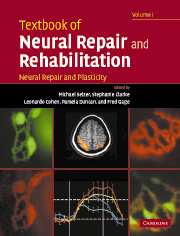Book contents
- Frontmatter
- Contents
- Contents (contents of Volume II)
- Preface
- Contributors (contributors of Volume I)
- Contributors (contributors of Volume II)
- Neural repair and rehabilitation: an introduction
- Section A Neural plasticity
- Section A1 Cellular and molecular mechanisms of neural plasticity
- Section A2 Functional plasticity in CNS system
- Section A3 Plasticity after injury to the CNS
- 13 Plasticity in the injured spinal cord
- 14 Plasticity after brain lesions
- 15 From bench to bedside: influence of theories of plasticity on human neurorehabilitation
- Section B1 Neural repair
- Section B2 Determinants of regeneration in the injured nervous system
- Section B3 Promotion of regeneration in the injured nervous system
- Section B4 Translational research: application to human neural injury
- Index
15 - From bench to bedside: influence of theories of plasticity on human neurorehabilitation
from Section A3 - Plasticity after injury to the CNS
Published online by Cambridge University Press: 05 March 2012
- Frontmatter
- Contents
- Contents (contents of Volume II)
- Preface
- Contributors (contributors of Volume I)
- Contributors (contributors of Volume II)
- Neural repair and rehabilitation: an introduction
- Section A Neural plasticity
- Section A1 Cellular and molecular mechanisms of neural plasticity
- Section A2 Functional plasticity in CNS system
- Section A3 Plasticity after injury to the CNS
- 13 Plasticity in the injured spinal cord
- 14 Plasticity after brain lesions
- 15 From bench to bedside: influence of theories of plasticity on human neurorehabilitation
- Section B1 Neural repair
- Section B2 Determinants of regeneration in the injured nervous system
- Section B3 Promotion of regeneration in the injured nervous system
- Section B4 Translational research: application to human neural injury
- Index
Summary
Introduction
In the last decade, our knowledge about the mechanisms of neurologic injury and recovery has improved. There is now considerable evidence that cortical representations are continuously modulated in response to practice and skill acquisition, a process often referred to as plasticity (Kaas, 1991; Donoghue et al., 1996). Plasticity can also be elicited by lesions in the central and peripheral nervous systems and may take place in cortical as well as subcortical structures (Kaas, 1991; Donoghue et al., 1996; Nudo and Milliken, 1996; Buonomano and Merzenich, 1998; Cohen et al., 1998; Jones and Pons, 1998; see Volume I, Chapters 6, 8 and 14). Cortical plasticity may thus be defined as any enduring change in cortical properties, as, for example, in the strength of internal connections, representation patterns, or neuronal properties, either morphologic or functional (Donoghue et al., 1996). Cortical reorganization can, depending on the settings, contribute to desirable behavioral developments, such as improved performance, or can be linked with unwanted outcomes like phantom pain (Flor et al., 1995; see Volume II, Chapter 15). The primary vehicle for acquiring knowledge on plasticity in the human central nervous system (CNS) has been animal research. Beginning in the 1970s, research from different laboratories (Merzenich et al., 1984; Kaas, 1991) showed that the adult mammalian CNS has the capacity to reorganize after injury. Understanding of mechanisms, development of strategies to purposefully modulate these mechanisms, and translation into rational strategies to promote recovery of function are the goals of modern neurorehabilitation.
Keywords
- Type
- Chapter
- Information
- Textbook of Neural Repair and Rehabilitation , pp. 248 - 266Publisher: Cambridge University PressPrint publication year: 2006
- 1
- Cited by

